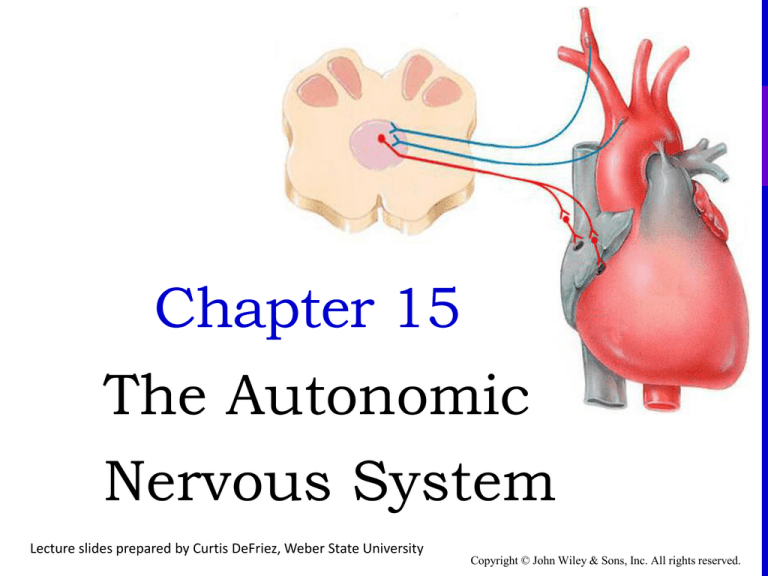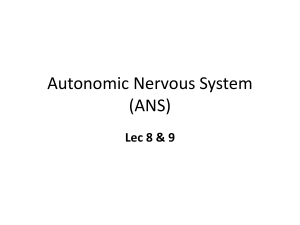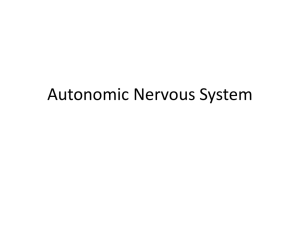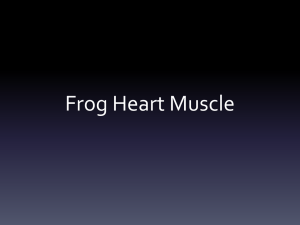
Chapter 15
The Autonomic
Nervous System
Lecture slides prepared by Curtis DeFriez, Weber State University
Copyright © John Wiley & Sons, Inc. All rights reserved.
Introduction to the ANS
In this chapter, we examine the structural and functional
features of the autonomic nervous system (ANS) and
compare the organization and actions of its two major
parts, the sympathetic and parasympathetic divisions.
The autonomic nervous system contributes to
homeostasis by responding to subconscious visceral
sensations and exciting or inhibiting smooth muscle,
cardiac muscle, and many glands.
Copyright © John Wiley & Sons, Inc. All rights reserved.
Introduction to the ANS
Structurally, the ANS includes autonomic sensory
neurons, integrating centers in the CNS, and autonomic
motor neurons.
The enteric division is a specialized network of nerves
and ganglia forming an independent nerve network
within the wall of the gastrointestinal (GI) tract. The
enteric division will not be further discussed in this
chapter, but we will return to it in Chapter 24.
Copyright © John Wiley & Sons, Inc. All rights reserved.
Introduction to the ANS
While both the ANS and the somatic nervous system
(SNS) include sensory and motor neurons, the ANS has
many distinctive features which set it apart.
Perhaps the biggest difference between these two
systems is the involvement of conscious control.
• In the SNS, feedback via tactile, thermal, pain, and
proprioceptive sensations are consciously perceived,
and skeletal muscle is the main tool used to provide
reflexive and voluntary movement.
Copyright © John Wiley & Sons, Inc. All rights reserved.
Introduction to the ANS
If a somatic motor neuron ceases to stimulate a muscle,
the result is a paralyzed, limp muscle that has no tone.
Although we are generally not conscious of breathing,
the muscles that generate respiratory movements are
skeletal muscles controlled by somatic motor neurons.
• If the respiratory motor neurons become inactive,
breathing stops.
Copyright © John Wiley & Sons, Inc. All rights reserved.
Introduction to the ANS
The ANS usually operates without conscious control,
though centers in the hypothalamus and brain stem do
provide regulation for ANS reflexes.
Sensory receptors called interoceptors located in blood
vessels, visceral organs, muscles, and the nervous system
monitor conditions in the internal environment.
• Examples of interoceptors are chemoreceptors that
monitor blood CO2 level and mechanoreceptors that
detect the degree of stretch in the walls of organs or
blood vessels.
Copyright © John Wiley & Sons, Inc. All rights reserved.
ANS Motor Pathways
Autonomic motor neurons regulate visceral activities by
either increasing (exciting) or decreasing (inhibiting)
ongoing activities in their effector tissues.
Because autonomic responses cannot be consciously
altered to any great degree, some autonomic responses
are the basis for polygraph (“lie detector”) tests.
However, practitioners of yoga and biofeedback
techniques may learn how to regulate at least some of
their autonomic activities through long practice.
Copyright © John Wiley & Sons, Inc. All rights reserved.
Introduction to the ANS
The anatomy of all autonomic pathways can best be
understood by picturing a double-barrelled neuronal
construct consisting of
a preganglionic neuron
leading to an intermediate
ganglion that contains
the cell bodies of postganglionic neurons
(that innervate an effector).
Copyright © John Wiley & Sons, Inc. All rights reserved.
Introduction to the ANS
Copyright © John Wiley & Sons, Inc. All rights reserved.
Introduction to the ANS
Interactions Animation
The ANS: An Introduction Animation
You must be connected to the internet to run this animation
Copyright © John Wiley & Sons, Inc. All rights reserved.
Divisions of the ANS
Most body organs have dual ANS innervation; that is,
they receive impulses from both sympathetic and
parasympathetic neurons.
Usually the nerve impulses from one division
stimulate an organ, while impulses from the other
division decrease activity.
Copyright © John Wiley & Sons, Inc. All rights reserved.
Divisions of
the ANS
Copyright © John Wiley & Sons, Inc. All rights reserved.
Divisions of
the ANS
Copyright © John Wiley & Sons, Inc. All rights reserved.
Divisions of the ANS
Furthermore, the responses of the various organs to
ANS stimulation neatly group into two functional
categories :
Like children on a teeter-totter, the sympathetic
divisions “fight or flight” response is balanced
against the “rest and relax” (or rest and digest)
activities of the parasympathetic division.
Copyright © John Wiley & Sons, Inc. All rights reserved.
The Sympathetic Division
The cell bodies of neurons which participate in motor
responses of the sympathetic nervous system are located
in the lateral horns of the gray matter in the 12 thoracic
segments and the first two lumbar segments of the cord.
Sympathetic preganglionic neurons exit the spinal
cord only between levels T1-L2 (hence the name
thoracolumbar division), though sympathetic ganglia
extend in the vicinity of the cord from the cervical to
the sacral region.
Copyright © John Wiley & Sons, Inc. All rights reserved.
The Sympathetic Division
Some of the major groups of sympathetic ganglia include:
The sympathetic trunk
(vertebral chain) ganglia
Prevertebral ganglia
The celiac, superior
mesenteric, inferior
mesenteric, aorticorenal
and renal ganglia
Copyright © John Wiley & Sons, Inc. All rights reserved.
The Sympathetic Division
Axons leave the sympathetic trunk in four possible ways:
They can enter and travel with spinal nerves.
They can form fine networks of periarterial
preganglionic traveling cephalad to synapse in the
cervical ganglia.
Postganglionic axons exiting the sympathetic trunk
can form sympathetic nerves to the heart and lungs.
Preganglionic axons can leave the sympathetic trunk
without synapsing and form splanchnic nerves.
Copyright © John Wiley & Sons, Inc. All rights reserved.
The Sympathetic Division
Major groups of sympathetic ganglia.
Copyright © John Wiley & Sons, Inc. All rights reserved.
The Sympathetic Division
A truism of the sympathetic division is that a single
sympathetic preganglionic fiber synapses with many
postganglionic branches (with 20 or more) to create a
diverging circuit.
The postganglionic axons typically terminate in several
different visceral effectors, making the effects of
sympathetic stimulation a widespread massive response.
• This is why anger can be hard to control – it is such a
diffuse response.
Copyright © John Wiley & Sons, Inc. All rights reserved.
The Sympathetic Division
This schematic
illustrates the outflow
of the sympathetic
division of the ANS via
thoracolumbar
pathways to the
many organs of the
body.
Copyright © John Wiley & Sons, Inc. All rights reserved.
The Parasympathetic Division
The cell bodies of preganglionic neurons which
participate in motor responses of the parasympathetic
nervous system are located in nuclei of 4 cranial nerves
in the brainstem (III, VII, IX and X) and in the lateral
gray matter of sacral areas of the spinal cord (S2-S4).
The vagus nerve (CN X) carries nearly 80% of the total
parasympathetic flow to the organs of the thorax and
upper abdomen. Lower abdominal and pelvic organs
are innervated by the sacral output.
Copyright © John Wiley & Sons, Inc. All rights reserved.
The Parasympathetic Division
Parasympathetic ganglia are called terminal ganglia
because they are located far from their origin at the
“terminal” ends of the pathways (near the target organs).
Four pairs of cranial parasympathetic ganglia
innervate structures in the head: The ciliary,
pterygopalatine, submandibular, and otic ganglia.
• The cranial-sacral division also has the ganglia
associated with the vagus (X) nerve and the sacral
nerves.
Copyright © John Wiley & Sons, Inc. All rights reserved.
Most of the parasympathetic ganglia are located
very close to the organs or intended action.
Copyright © John Wiley & Sons, Inc. All rights reserved.
The Parasympathetic Division
The sacral preganglionic axons branch off of sacral spinal
nerves to form pelvic splanchnic nerves which synapse with
parasympathetic postganglionic neurons located in terminal
ganglia in the walls
of the innervated viscera.
From the terminal ganglia,
postganglionic axons innervate
smooth muscle and glands in
the walls of the colon, ureters,
urinary bladder, and
reproductive organs
Copyright © John Wiley & Sons, Inc. All rights reserved.
The Parasympathetic Division
In contrast to the sympathetic system, the
parasympathetic response is more controlled.
Presynaptic parasympathetic neurons usually synapse
with only 4–5 postsynaptic neurons, all of which
supply a single visceral effector. Parasympathetic
stimulation leads to a narrow, focused action on
specific organs.
• This is why it is possible to walk and chew gum at
the same time (not really!)
Copyright © John Wiley & Sons, Inc. All rights reserved.
The division of the sympathetic and parasympathetic
divisions of the ANS are compared in Table 15.3
Copyright © John Wiley & Sons, Inc. All rights reserved.
ANS Neurotransmitters
The total number of neurotransmitters used in the entire
nervous system is not known, but is well over 100.
Despite the variety of possible chemicals that could be
used to transmit chemical messages in the ANS, only 2,
acetylcholine and norepinephrine, are used to any great
degree.
• Synapses at which ACh is used are termed cholinergic.
• Synapses at which norepinephrine or epinephrine are
used are termed adrenergic.
Copyright © John Wiley & Sons, Inc. All rights reserved.
ANS Neurotransmitters
The neurotransmitter used in all of the synapses of
sympathetic and parasympathetic ganglia (between the
synapses of the preganglionic and postganglionic fibers)
is acetylcholine.
Receptors that respond to Ach released by these
cholinergic neurons are called cholinergic receptors
and there are 2 subtypes: nicotinic receptors (found in
the ganglia) and muscarinic receptors (found in the
synapses with the effector organs).
Copyright © John Wiley & Sons, Inc. All rights reserved.
ANS Neurotransmitters
Acetylcholine acts on a sub-type
of cholinergic receptor (called
nicotinic receptors) at ganglia of
the ANS.
Copyright © John Wiley & Sons, Inc. All rights reserved.
ANS Neurotransmitters
The neurotransmitter used at most
sympathetic postganglionic
synapses is norepinephrine.
The exception to this rule is
that ACh is used at sympathetic
postganglionic synapses for
sweat glands.
Copyright © John Wiley & Sons, Inc. All rights reserved.
ANS Neurotransmitters
The neurotransmitter used
at all parasympathetic
postganglionic synapses
is Ach.
These are all a variety
of cholinergic receptors
called muscarinic.
Copyright © John Wiley & Sons, Inc. All rights reserved.
ANS Neurotransmitters
Neurons and Neurotransmitters of the Parasympathetic
Nervous System
Preganglionic
Postganglionic
Cell body in brain or
spinal cord
Cell body in intramural
ganglion
Acetylcholine (ACh)
Acetylcholine (ACh)
Copyright © John Wiley & Sons, Inc. All rights reserved.
ANS Neurotransmitters
Neurons and Neurotransmitters of
the Sympathetic Nervous System
Preganglionic
oCell body in lateral horn of
ospinal cord
oAcetylcholine (ACh)
Postganglionic
Cell body in sympathetico
chain gangliono
(norepinephrine, NE) ol
except sweat glands (Ach) o
Copyright © John Wiley & Sons, Inc. All rights reserved.
ANS Neurotransmitters
Interactions Animation
ANS Neurotransmitters and Neurons Animation
You must be connected to the internet to run this animation
Copyright © John Wiley & Sons, Inc. All rights reserved.
Physiology of the ANS
Sympathetic stimulation leads to secretion of
norepinephrine by the adrenal glands, an increase in the
rate and strength of the heartbeat, constriction of blood
vessels of non-essential organs, dilation of vessels of
essential organs (skeletal muscle and the cerebral cortex),
an increase in the rate and depth of breathing, hepatic
conversion of glycogen to glucose, and decrease in GI
activity.
Copyright © John Wiley & Sons, Inc. All rights reserved.
Physiology of the ANS
Copyright © John Wiley & Sons, Inc. All rights reserved.
Physiology of the ANS
Copyright © John Wiley & Sons, Inc. All rights reserved.
Physiology of the ANS
Copyright © John Wiley & Sons, Inc. All rights reserved.
Physiology of the ANS
SLUDD is as an acronym used to describe the responses of
the parasympathetic nervous system:
Salivation (increased)
Lacrimation (increased)
Urination (increased)
Digestion (increased)
Defecation (increased)
• … and 3 decreases (in the rate and force of the heart
beat, airway size and rate of breathing, and pupil size)
Copyright © John Wiley & Sons, Inc. All rights reserved.
Physiology of the ANS
Interactions Animation
The balance of autonomic sympathetic-parasympathetic tone is
regulated by feedback loops between the spinal cord and
brainstem, with input from the limbic system and oversight by
the hypothalamus.
Physiological Effects of the ANS Animation
You must be connected to the internet to run this animation
Copyright © John Wiley & Sons, Inc. All rights reserved.
End of Chapter 15
Copyright 2012 John Wiley & Sons, Inc. All rights reserved.
Reproduction or translation of this work beyond that permitted
in section 117 of the 1976 United States Copyright Act without
express permission of the copyright owner is unlawful. Request
for further information should be addressed to the Permission
Department, John Wiley & Sons, Inc. The purchaser may make
back-up copies for his/her own use only and not for distribution
or resale. The Publisher assumes no responsibility for errors,
omissions, or damages caused by the use of these programs or
from the use of the information herein.
Copyright © John Wiley & Sons, Inc. All rights reserved.









